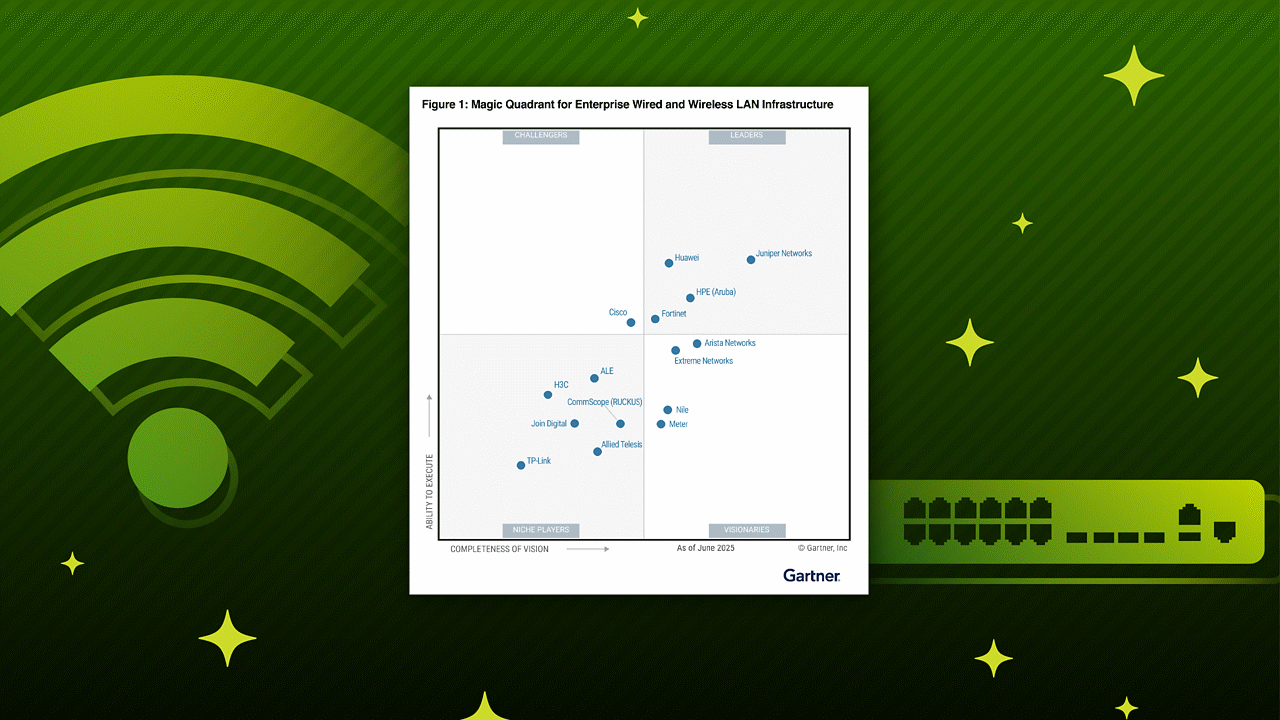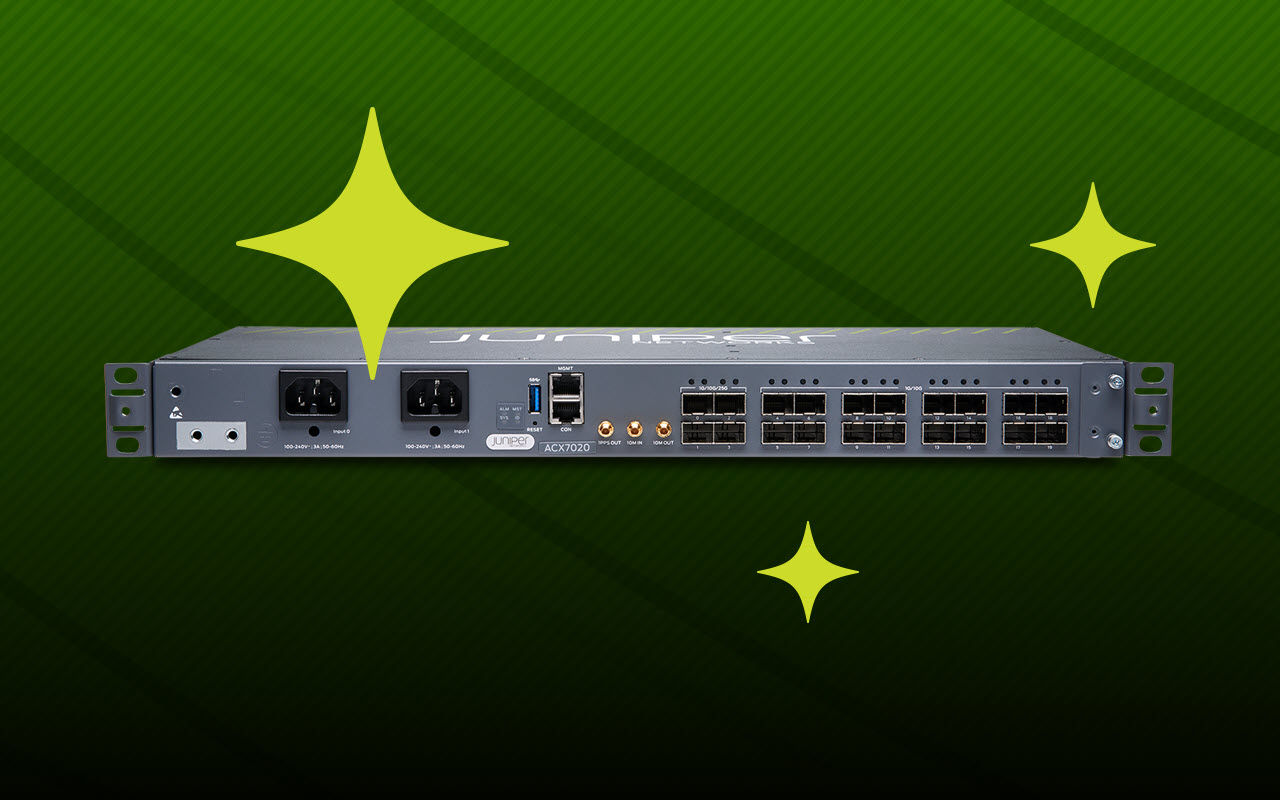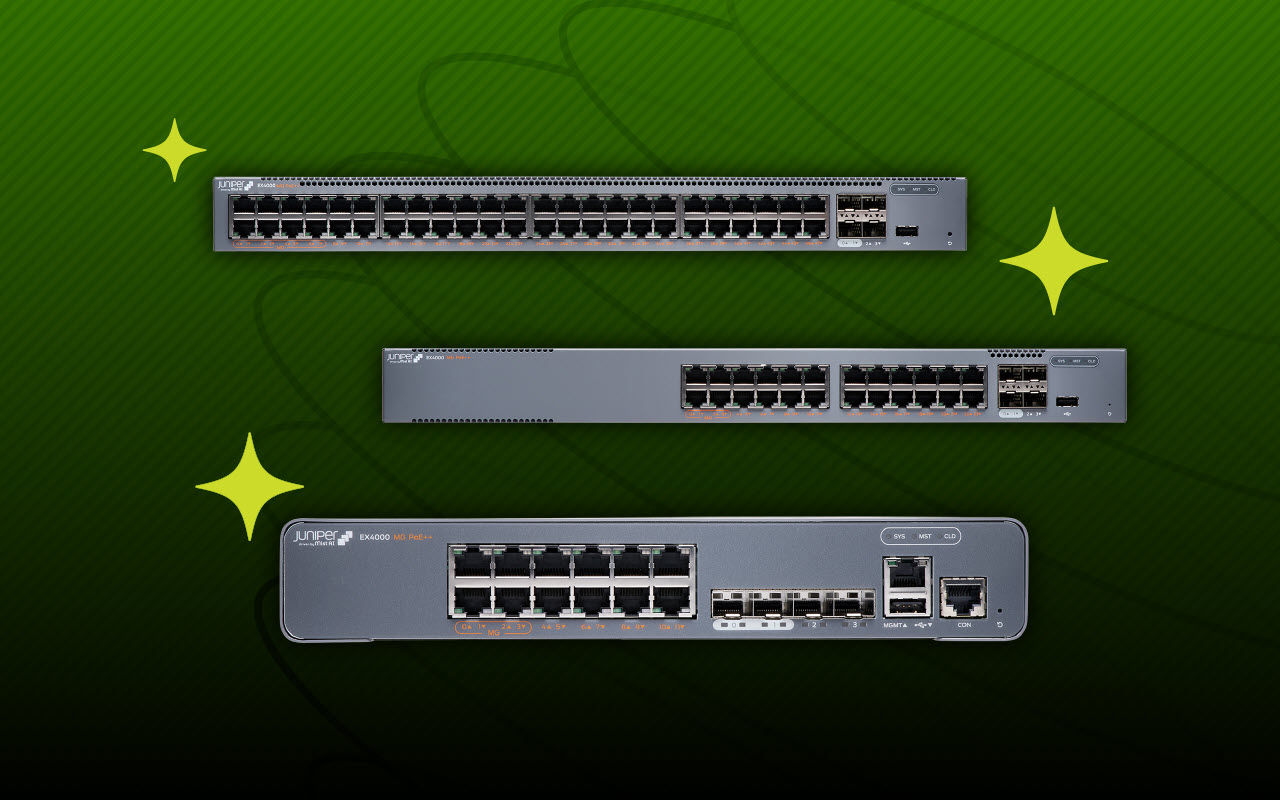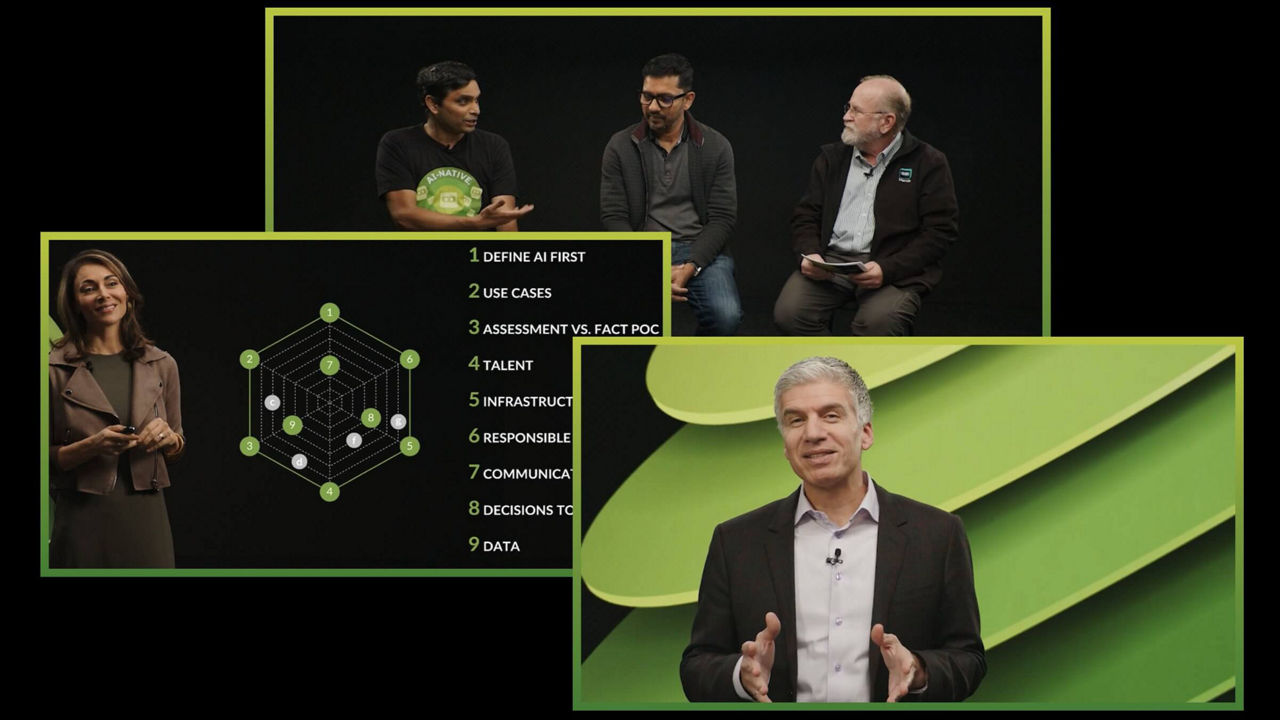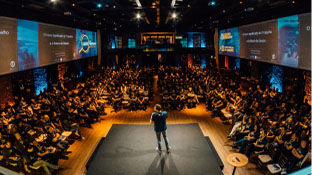QFX5130 Line of Switches Datasheet
Download DatasheetProduct overview
Juniper Networks QFX5130 line of Switches supports modern data center workloads that demand a top-of-rack switch with multiple speeds. The high-speed, high-density, cost optimized 1 U fixed platform is ideal for spine-and-leaf IP fabrics. Supporting 400GbE, 200GbE, 100GbE, 50GbE, 40GbE, 25GbE, and 10GbE connections and offering advanced L2/L3 features, and secure ZTP, the QFX5130 line enables network operators to build large, next-generation IP fabrics. The switches are based on a proven, Internet-scale software suite with best-in-class automation and management capabilities.

Product description
Juniper Networks® QFX5130 line of Switches is a high-radix, high-density, 1 U platform suitable for today’s data centers. The four options are a perfect choice for leaf, border leaf, and spine roles within IP networks, as well as Ethernet VPN - Virtual Extensible LAN (EVPN-VXLAN) fabrics. For large public cloud providers—early adopters of high-performance servers to meet increasing workload growth—the QFX5130 line supports very large, dense, and fast 400GbE IP fabrics based on proven, Internet-scale technology. For enterprise data center customers seeking investment protection as they transition their server farms from 10GbE to 25GbE, the QFX5130 line switch provides a high radix-native 100GbE/400GbE EVPN-VXLAN option with reduced power and a smaller footprint.
Additional Remote Direct Memory Access over Converged Ethernet (RoCEv2) capabilities in the QFX5130 line make it suitable in IP storage deployments. Instead of relying on deep buffer switching, QoS mechanisms such as Priority-based Flow Control-DiffServ code point (PFC-DSCP) and Explicit Congestion Notification (ECN) help deliver high performance for storage workloads. Support for high-power 400G-ZR and 400G-ZR-M optics makes it suitable for edge and DCI use cases.
Product options
The QFX5130 line of Switches includes four compact 1 U platforms—QFX5130‑32CD, QFX5130E‑32CD, QFX5130‑48C, and QFX5130‑48CM. All provide high speeds, high densities, and a rich set of Junos® OS Evolved operating system features.
The Juniper Networks QFX5130-32CD and QFX5130E-32CD switches are next-generation, fixed-configuration spine-and-leaf switches featuring:
- 32 400G QSFP-DD ports in 1 U form factor
- Up to 25.6 Tbps (bidirectional)/5.3 bpps throughput
Using breakout cables, each of the 32 400GbE QSFP-DD ports can be broken into four 100/25/10GbE ports, increasing the total number of supported 100/25/10GbE ports per switch to 128.
The Juniper Networks QFX5130‑48C and QFX5130‑48CM (MACsec) Switch is a next‑generation, high‑density, and cost‑efficient 100GbE and 400GbE optimized fixed system featuring:
- Native 48 SFP56‑DD100GbE ports for server connectivity
- Native 8 QSFP‑DD 400GbE uplink ports
- Up to 16 Tbps (bidirectional)/2.7 bpps throughput
- With MACsec enabled on QFX5130‑48CM:
- Up to 9.6 Tbps (bidirectional)/2.7 bpps MACsec encryption support
- 32x 100G SFP56‑DD and 4x 400G QSFP‑DD MACsec port support
Using breakout cables, the total number of supported 100/25/10GbE ports per switch can be increased to 72.
Product highlights
Increased scale and buffer
The QFX5130-32CD switch provides enhanced scale with up to 1.24 million routes, 80,000 firewall filters, and 160,000 media access control (MAC) addresses. It supports high numbers of egress IPv4/IPv6 rules by programming matches in egress ternary content addressable memory (TCAM) along with ingress TCAM.
Increased port density
The QFX5130‑48C and QFX5130‑48CM support 100GbE ports with SFP56‑DD form‑ factor, which helps to increase the number of ports that can be supported in a standard 1U box. This increase in port density is achieved with reduced power consumption and makes it an excellent choice for a top‑of‑rack device.
Features and benefits
- Power efficiency: With its low-power 7 nm process, the QFX5130-32CD and QFX5130E-32CD bring improvements in speed, lower power consumption, and higher density on chip. The QFX5130-48C brings improvements in total power consumption and better power efficiency per port.
- Shared packet buffer: Today’s cloud-native applications depend on buffer size to prevent congestion and packet drops. The QFX5130 line of switches has a shared packet buffer that is allocated dynamically to congested ports. Having the right amount of on buffer is critical to preventing congestion and packet drops.
- Automation and programmability: The QFX5130 line supports multiple network automation features for plug-and-play operations, including zero-touch provisioning (ZTP), Network Configuration Protocol (NETCONF), Juniper Extension Toolkit (JET), Junos telemetry interface, operations and event scripts, automation rollback, and Python scripting.
The QFX5130 line revolutionizes performance for data center networks by providing a programmable software-defined pipeline. The QFX5130 line uses a compiler-driven switch data plane with full software program control to enable and serve a diverse set of use cases, including in-band telemetry, fine-grained filtering for traffic steering, traffic monitoring, and support for new protocol encapsulations. - Cloud-level scale and performance: The QFX5130 line supports best-in-class, cloud-based, L2/L3 deployments with superior scale and performance and latency as low as 1000 ns (store and forward). The switches support up to 128 link aggregation groups, 4096 VLANs, and jumbo frames of 9216 bytes. Junos OS Evolved provides configurable options through a CLI, enabling each QFX5130 to be optimized for different deployment scenarios.
- VXLAN overlays: The QFX5130 line is capable of both L2 and L3 gateway services. Enterprises, cloud operators, and service providers can deploy overlay networks to provide L2 adjacencies for applications over L3 fabrics. The overlay networks use VXLAN in the data plane and EVPN for programming the overlays, which can operate without a controller or be orchestrated with an SDN controller.
- IEEE 1588 PTP Boundary Clock with Hardware Timestamping: IEEE 1588 PTP transparent/boundary clock is supported on QFX5130-32CD and QFX5130E-32CD, enabling accurate and precise sub-microsecond timing information in today’s data center networks. In addition, the QFX5130-32CD and QFX5130E-32CD support hardware timestamping; timestamps in Precision Time Protocol (PTP) packets are captured and inserted by an onboard field-programmable gate array (FPGA) on the switch at the physical (PHY) level.
- RoCEv2: As a switch capable of transporting data as well as storage traffic over Ethernet, the QFX5130 line provides an IEEE data center bridging (DCB) converged network between servers with disaggregated flash storage arrays or an NVMe-enabled SAN. The QFX5130 line offers a full-featured DCB implementation that provides strong monitoring capabilities on the top-of-rack switch for SAN and LAN administration teams to maintain clear separation of management.
- Junos OS Evolved features: The QFX5130 line supports features such as L2/L3 unicast, EVPN-VXLAN, BGP add-path, RoCEv2 and congestion management, multicast, 128-way ECMP, dynamic load balancing capabilities, enhanced firewall capabilities, and monitoring.
- Junos OS Evolved Architecture: Junos OS Evolved is a native Linux operating system that incorporates a modular design of independent functional components and enables individual components to be upgraded independently while the system remains operational. Component failures are localized to the specific component involved and can be corrected by upgrading and restarting that specific component without bringing down the entire device. The switch’s control and data plane processes can run in parallel, maximizing CPU utilization, providing support for containerization, and enabling application deployment using LXC or Docker.
- Retained state: State is the retained information or status pertaining to physical and logical entities. It includes both operational and configuration state, comprising committed configuration, interface state, routes, hardware state, and what is held in a central database called the distributed data store (DDS). State information remains persistent, is shared across the system, and is supplied during restarts.
- Feature support: All key networking functions such as routing, bridging, management software, and management plane interfaces, as well as APIs such as CLI, NETCONF, JET, Junos telemetry interface, and the underlying data models, resemble those supported by the Junos operating system. This ensures compatibility and eases the transition to Junos Evolved.
- Automation and Monitoring: Apstra Data Center Director (formerly Juniper Apstra) delivers full Day 0 through Day 2+ capabilities for IP/EVPN fabrics with closed-loop assurance in the data center for the QFX5130 line of switches. Data Center Director is the state-of-the art fabric management solution that empowers organizations to automate and manage their networks across virtually any data center design, vendor, and topology, making private data center as easy as cloud. Data Center Director provides full Day 2+ operations assurance with multiple built-in intent-based analytics probes to assure your network is running as designed, plus Data Center Director provides a simple UI workflow to create custom intent-based analytics to capture, enrich, and visualize data from the managed devices. Data Center Director also provides the capability to capture and analyze flow data to provide complete network visibility.
Additionally, the Junos Evolved operating system supports a robust API set to support automation through Terraform, Ansible, ZTP, operations and event scripts, automatic rollback, and Python scripts. The QFX5130 line supports Junos telemetry interface, a modern telemetry streaming tool that provides performance monitoring in complex, dynamic data centers.
Junos Telemetry Interface
Streaming data to a performance management system lets network administrators measure trends in link and node utilization and troubleshoot issues such as network congestion in real time.
Junos Telemetry Interface provides:
- Application visibility and performance management by provisioning sensors to collect and stream data and analyze the application and workload flow path through the network
- Capacity planning and optimization by proactively detecting hotspots and monitoring latency and microbursts
- Troubleshooting and root cause analysis via high-frequency monitoring and correlating overlay and underlay networks
Deployment options
Data center fabric deployments
The QFX5130 line can be deployed as a universal device in cloud data center to support 100GbE and 200GbE (with QFX5130-32CD and QFX5130E-32CD) server access and 400GbE spine-and-leaf configurations. This optimizes data center operations by using a single device across multiple network layers. The QFX5130 line can also be deployed in more advanced overlay architectures like an EVPN-VXLAN fabric. Depending on where tunnel terminations are desired, the QFX5130 line can be deployed in either Edge Routed Bridging (ERB) deign or the Bridged Overlay architecture. Juniper offers complete flexibility and a range of data center fabric designs that cater to data centers of different sizes and scalability in cloud operator, service provider, and enterprise environments.
- Architecture 1: Edge Routed Bridging (ERB) EVPN-VXLAN with distributed anycast IP gateway architecture supporting L2 and L3 for enterprises and 5G Telco-Cloud. This type of design offers a combination of L2 stretch between multiple leaf/top-of-rack switches and L2 active/active multihoming to the server with MAC-VRF EVI L2 virtualization support as well as L3 IP VRF virtualization at the leaf/top of rack through the Type-5 EVPN-VXLAN. This type of design in data centers can be used for optimized and redundant connections toservers/compute nodes, Blade Center, IP storage nodes running ROCEv2, as well as other appliances.
- Architecture 2: Bridged Overlay (BO) EVPN-VXLAN design using MAC-VRF instances and different EVPN service-types (VLAN‑aware, VLAN‑bundle, VLAN‑based). In this case an external to the fabric first hop IP gateway can be used, such as at the firewall or external, existing, data center gateway routers. In this design the data center fabric is offering L2 active/active multihoming using ESI-LAG and fabric wide-L2 stretch between the leaf top-of-rack nodes.
- Architecture 3: Seamless DCI for ERB fabric design DCI border-leaf design with seamless T2/T2 EVPN-VXLAN to EVPN-VXLAN tunnel stitching (RFC 9014) and T5/T5 EVPN-VXLAN tunnel stitching support. With this design the data center gets the benefit of geographical redundancy for the application deployed in the private cloud data center. The QFX5130 line is used in this design also as a border-leaf node.
- Architecture 4: Collapsed spine design with ESI-LAG support and anycast IP In this case a pair of QFX5130 switches is deployed with a back-to-back connect, without a spine layer. The L2 active/active multihoming using ESI-LAG is used for the server NIC high availability as well as anycast IP gateway.
Campus fabric deployments
The QFX5130-32CD can be deployed in campus core, distribution and access layer networks using 100GbE/400GbE ports to support technologies such as EVPN multihoming and campus fabrics. Juniper offers complete flexibility in choosing any of the following validated EVPN-VXLAN designs that cater to networks of different sizes, scale, and segmentation requirements:
- EVPN multihoming (collapsed core or distribution): A collapsed core architecture combines the core and distribution layers into a single switch, turning the traditional three-tier hierarchal network into a two-tier network. EVPN Multihoming on a collapsed core eliminates the need for Spanning Tree Protocol (STP) across campus networks by providing link aggregation capabilities from the access layer to the core layer. This architecture is best suited for small to medium distributed enterprise networks and allows for consistent VLANs across the network. It uses ESI (Ethernet Segment Identifier) LAG (Link Aggregation) and is a standards-based protocol.
- Campus Fabric Core distribution: When EVPN-VXLAN is configured across core and distribution layers, it becomes a campus Fabric Core Distribution architecture, which can be configured in two modes: centrally or edge routed bridging overlay. This architecture provides an opportunity for an administrator to move toward campus-fabric IP Clos without a fork-lift upgrade of all access switches in the existing network, while bringing in the advantages of moving to a campus fabric and providing an easy way to scale out the network.
- Campus Fabric IP Clos: When EVPN-VXLAN is configured on all layers including access, it is called the campus fabric IP Clos architecture. This model is also referred to as “end-to-end,” given that VXLAN tunnels are terminated at the access layer. The availability of VXLAN at access provides policy enforcement and micro segmentation to the access layer (closest to the source) using standards-based Group Based Policy (GBP) to segment traffic even within a VLAN. GBP tags are assigned dynamically to clients as part of Radius transaction by Juniper campus and branch cloud NAC. This topology works for small, medium, and large campus architectures that need macro and micro segmentation.
In all these EVPN-VXLAN deployment modes, the QFX5130 line can be used in the distribution or core. All three topologies are standards-based and interoperable with third-party vendors.
Features
| Layer 2 | |
| STP—IEEE 802.1D (802.1D-2004) | |
| Rapid Spanning Tree Protocol (RSTP) (IEEE 802.1w); MSTP (IEEE 802.1s) | |
| Bridge protocol data unit (BPDU) protect | |
| Loop protect | |
| Root protect | |
| VLAN—IEEE 802.1Q VLAN trunking | |
| Routed VLAN interface (RVI) | |
| Static MAC address assignment for interface | |
| Global MAC learning disable | |
| Link Aggregation and Link Aggregation Control Protocol (LACP) (IEEE 802.3ad) | |
| IEEE 802.1AB Link Layer Discovery Protocol (LLDP) | |
| Link Aggregation | |
| LAG load sharing algorithm—bridged or routed (unicast or multicast) traffic: - IP: Session Initiation Protocol (SIP), Dynamic Internet Protocol (DIP), TCP/UDP source port, TCP/UDP destination port - L2 and non-IP: MAC SA, MAC DA, Ether type, VLAN ID, source port | |
| Layer 3 Features | |
| Static routing | |
| OSPF v2/v3 | |
| Filter-based forwarding | |
| VRRP/VRRPv3 | |
| IPv6 | |
| Virtual routers | |
| Loop-free alternate (LFA) | |
| BGP | |
| IS-IS | |
| Dynamic Host Configuration Protocol (DHCP) v4/v6 relay(stateless) | |
| VRF-aware DHCP | |
| Security and Filters | |
| Secure interface login and password | |
| Secure boot | |
| RADIUS | |
| TACACS+ | |
| Ingress and egress filters: Allow and deny, port filters, VLAN filters, and routed filters, including management port filters and loopback filters for control plane protection. | |
| Filter actions: Logging, system logging, reject, mirror to an interface, counters, assign forwarding class, permit, drop, police, mark | |
| SSH v1, v2 | |
| Static ARP support | |
| Storm control, port error disable, and auto recovery | |
| Control plane denial-of-service (DoS) protection | |
| Image rollback | |
| Multicast | |
| Internet Group Management Protocol (IGMP) v1/v2/v3 | |
| Multicast Listener Discovery (MLD) v2 | |
| IGMP proxy, querier | |
| IGMP v1/v2/v3 snooping | |
| Intersubnet multicast using IRB interface | |
| MLD snooping | |
| Protocol Independent Multicast PIM-SM, PIM-SSM, PIM-DM, PIM-Bidir | |
| Multicast Source Discovery Protocol (MSDP) | |
| Quality of Service (QoS) | |
| L2 and L3 QoS: Classification, rewrite, queuing Rate limiting: - Ingress policing: 1 rate 2 color, 2 rate 3 color - Egress policing: Policer, policer mark down action - Egress shaping: Per queue, per port | |
| 10 hardware queues per port (8 unicast and 2 multicast) | |
| Strict priority queuing (LLQ), shaped-deficit weighted round robin (SDWRR) | |
| Layer 2 classification criteria: Interface, MAC address, Ether type, 802.1p, VLAN | |
| Congestion avoidance capabilities: WRED, ECN | |
| Trust IEEE 802.1p | |
| Configurable shared buffer and buffer monitoring | |
| Congestion Notification Profile | |
| Priority-based flow control (PFC)—IEEE 802.1Qbb | |
| EVPN-VXLAN | |
| EVPN support with VXLAN transport | |
| EVPN pure type-5 route support with symmetric inter-irb routing | |
| All-active multihoming support for EVPN-VXLAN (ESI-LAG, EVPN-LAG) | |
| Multiple EVI (EVPN instances) for multiple MAC-VRF for Mac advertisement | |
| MAC-VRF (EVI) multiple EVPN service-type support: VLAN-based, VLAN-aware, VLAN-bundle | |
| ARP/ND suppression for proxy-arp/nd | |
| Ingress multicast Replication | |
| IGMPv2 snooping support fabric wide: using EVPN route type-6 | |
| IGMPv2 snooping support for L2 multihoming scenarios: - EVPN route type-7 and type-8 - IP prefix advertisement using EVPN with VxLAN encapsulation - Symmetric inter-irb routing using RT2/MAC-IP (Integrated Routing and Bridging in Ethernet VPN (EVPN) - IP Prefix Advertisement in Ethernet VPN (EVPN-VxLAN) | |
| DCI using seamless tunnel stitching EVPN-VxLAN to EVPN-VxLAN (Interconnect Solution for EVPN Overlay Networks | |
| OISM - EVPN Optimized Inter-Subnet Multicast (OISM) Forwarding (draft-ietf-bess-evpn-irb-mcast) | |
| Multicast Assisted Replication AR-leaf and AR-spine: Optimized Ingress Replication solution for EVPN (draft-ietf-bess-evpn-optimized-ir) | |
| Network Virtualization Overlay Solution Using EVPN RFC 8365: MAC-VRF instances support with VLAN-based, VLAN-aware, VLAN-bundle service-types in EVPN-VxLAN fabric | |
| Data Center Bridging (DCB) | |
| Explicit congestion notification (ECN) | |
| Priority-based flow control (PFC)—IEEE 802.1Qbb | |
| High Availability | |
| Bidirectional Forwarding Detection (BFD) | |
| Visibility and Analytics | |
| Switched Port Analyzer (SPAN) | |
| Remote SPAN (RSPAN) | |
| Encapsulated Remote SPAN (ERSPAN) | |
| sFlow v5 | |
| Junos Telemetry Interface Management and Operations | |
| Management and Operations | |
| Role-based CLI management and access | |
| CLI via console, telnet, or SSH | |
| Extended ping and traceroute | |
| Junos OS Evolved configuration rescue and rollback | |
| SNMP v1/v2/v3 | |
| Junos OS Evolved XML management protocol | |
| High frequency statistics collection | |
| Automation and orchestration | |
| ZTP | |
| Python | |
| Junos OS Evolved event, commit, and OP scripts | |
| Apstra Data Center Director management, monitoring, and analytics for data center fabrics | |
| Juniper Wired Assurance for Campus | |
Software scale
| Software | QFX5130-32CD | QFX5130E-32CD | QFX5130-48C and QFX5130-48CM |
| Operating System | Junos Evolved | Junos Evolved | Junos Evolved |
| MAC addresses per system | 160,000 | 96,000 | 96,000 |
| VLAN IDs | 4,000 | 4,000 | 4,000 |
| Number of link aggregation groups (LAGs) | 128 | 128 | 72 |
| Ingress routed ACL (RACL) | 4*20k per Pipe | 4*10k per Pipe | 28,671 (for two pipes) |
| Ingress VLAN ACL (VACL) | 20k | 10k | 14,335 (for two pipes) |
| Ingress port ACL (PACL) | 4*20k per Pipe | 4*10k per Pipe | 28,671 (for two pipes) |
| Egress routed ACL (RACL) | 4*1k per Pipe | 4*1k per Pipe | 2*1,000 per Pipe |
| Egress VLAN ACL (VACL) | 2,000 | 2,000 | 2,000 |
| Egress port ACL (PACL) | 4*2k per Pipe | 4*2k per Pipe | 2*2,000 per pipe |
| IPv4/v6 unicast routes | 1.2M/850K | 732K/428K | 700/360K |
| ARP entries | 32,000 | 32,000 | 32,000 |
| Jumbo frame | 9,216 Bytes | 9,216 Bytes | 9,216 Bytes |
| Traffic mirroring destination ports per switch | 4 | 4 | 4 |
| Maximum number of mirroring sessions | 4 | 4 | 4 |
| Traffic mirroring destination vlans per switch | 4 | 4 | 4 |
| Shared Packet Buffer (MB) | 132 | 132 | 82 |



Specifications
Hardware specifications
| Specification | QFX5130-32CD and QFX51320E-32CD | QFX5130-48C and QFX5130-48CM |
| System throughput | Up to 12.8/25.6 Tbps (uni/ bidirectional) | Up to 8/16 Tbps (uni/bidirectional) |
| Forwarding capacity | 5.3 billion packets per second | 2.7 billion packets per second |
| Port density | 32 ports of QSFP-DD 400GbE | 48 ports of SFP56-DD and 8 port of QSFP-DD 400GbE |
| Max ports with breakout | 64 x 200GbE + 2 x 10GbE or 128 x 100/50/25/10GbE + 2 x 10GbE or 32 x 40GbE + 2 x 10GbE | 16 x 200GbE + 48 x 100/50/25/10GbE + 2 x 10 GbE or 72 x 100/50/25/10GbE + 2 x 10GbE or 74 x 10 GbE |
| Dimensions (W x H x D) | 17.26 x 1.72 x 21.1 in. (43.8 x 4.3 x 53.59 cm) | 17.28 x 1.72 x 20.5 inches |
| Rack units | 1 U | 1 U |
| Weight | 24.5 lbs. (11.1 kg) with power supplies and fans installed | 27 lbs. (12.24 kg) with power supplies and fans installed |
| Operating system | Junos OS Evolved | Junos OS Evolved |
| Switch chip | Broadcom Trident4 | Broadcom Trident4 |
| CPU | Intel Broadwell DE | Intel Ice Lake (4 core) |
| Memory | 32GB (16GBx2) of DDR4 | 32GB (16GBx2) of DDR4 |
| Storage | 2x50GB | 2x100GB |
| Power | Redundant (1+1) hot-pluggable 1600 W AC/DC power supplies | Redundant (1+1) hot-pluggable 1600 W AC/DC power supplies |
| Cooling | Ports-to-FRUs (AFO) and FRUs-to-ports (AFI) cooling 6 fan trays, redundancy (5+1) hot-pluggable fan modules | Ports-to-FRUs (AFO) and FRUs-to-ports (AFI) cooling 6 fan trays, redundancy (5+1) at rotor level, hot-pluggable fan modules |
| Total packet buffer | 132 MB | 82 MB |
| Warranty | Juniper standard one-year warranty | Juniper standard one-year warranty |
| AC Input | Voltage: 115-127 VAC, 12 A / 200-240 VAC, 8 A, Frequency: 50/60 Hz | Voltage: 100-127 VAC, 12 A / 200–240 VAC, 9 A, Frequency: 50/60 Hz |
| DC Input | Voltage: -48V - -60VDC, 35 A max | Voltage: -48V - -60VDC, 40 A max |
Environmental ranges
| Parameter | Specification | |
| QFX5130-32CD/QFX5130E-32CD | QFX5130-48C/48CM | |
| Operating temperature | 0° to 40°C for AFO system, 0° to 30°C for AFI system | 0° to 40°C for AFO system, 0° to 40°C for AFI system |
| Storage temperature | -40° to 70°C | |
| Operating altitude | AFO: 6000 ft at 40C AFI: Sea level at 30C | AFO: 6000 ft at 40C AFI*: 6000 ft* at 40C |
| Relative humidity operating | 5 to 90% noncondensing | |
| Relative humidity nonoperating | 5 to 90% noncondensing | |
| Seismic | Zone 4 earthquake rating | |
| Parameter | QFX5130-32CD & QFX5130E-32CD | QFX5130-48C & QFX5130-48CM |
| Maximum power draw | 220-240 V: 839 W (AC), 871 W (DC) | 220-240 V: 609 W (AC), 587 W (DC) |
| Typical power draw | 220-240 V: 323 W (AC), 341 W (DC) | 220-240 V: 219 W (AC), 238 W (DC) |
| Safety Approvals | |
| UL 60950-1:2007 R5.19 Information Technology Equipment—Safety | |
| CAN/CSA-C22.2 No. 60950-1-07+A1:2011+A2:2014 Information Technology Equipment—Safety | |
| IEC 62368-1:2014 Audio/Video, Information and Communication Technology Equipment—Safety (All country deviations) | |
| IEC 62368-1:2018 Audio/Video, Information and Communication Technology Equipment—Safety (All country deviations) | |
| UL 62368-1:2019 R10.21 Audio/Video, Information and Communication Technology Equipment—Safety | |
| CSA C22.2 No. 62368-1:19, Audio/Video, Information and Communication Technology Equipment—Safety | |
| IEC/EN 60825-1 Safety of Laser Products—Part 1: Equipment Classification and Requirements | |
| Security | |
| TAA | |
| Electromagnetic Capability (EMC) | |
| 47 CFR Part 15, (FCC) Class A | |
| ICES-003 Class A | |
| EN 55022/EN 55032, Class A | |
| CISPR 22/CISPR 32, Class A | |
| EN 55024 | |
| EN 300 386 | |
| VCCI Class A | |
| AS/NZS CISPR 32, Class A | |
| KN32/KN35 | |
| BSMI CNS 13438, Class A | |
| EN 61000-3-2 | |
| EN 61000-3-3 | |
| Telco | |
| Common Language Equipment Identifier (CLEI) code | |
| Environmental Compliance | |
| Restriction of Hazardous Substances (ROHS) | |
| Waste Electronics and Electrical Equipment (WEEE) | |
| Safety Approvals | |
| UL 60950-1:2007 R5.19 Information Technology Equipment—Safety | |
| CAN/CSA-C22.2 No. 60950-1-07+A1:2011+A2:2014 Information Technology Equipment—Safety | |
| IEC 62368-1:2014 Audio/Video, Information and Communication Technology Equipment—Safety (All country deviations) | |
| IEC 62368-1:2018 Audio/Video, Information and Communication Technology Equipment—Safety (All country deviations) | |
| UL 62368-1:2019 R10.21 Audio/Video, Information and Communication Technology Equipment—Safety | |
| CSA C22.2 No. 62368-1:19, Audio/Video, Information and Communication Technology Equipment—Safety | |
| IEC/EN 60825-1 Safety of Laser Products—Part 1: Equipment Classification and Requirements | |
| Security | |
| TAA | |
| Electromagnetic Capability (EMC) | |
| FCC 47 CFR Part 15 | |
| ICES-003 / ICES-GEN | |
| BS EN 55032 | |
| BS EN 55035 | |
| EN 300 386 V1.6.1 | |
| EN 300 386 V2.2.1 | |
| BS EN 300 386 | |
| EN 55032 | |
| CISPR 32 | |
| EN 55035 | |
| CISPR 35 | |
| IEC/EN 61000 Series | |
| IEC/EN 61000-3-2 | |
| IEC/EN 61000-3-3 | |
| AS/NZS CISPR 32 | |
| VCCI-CISPR 32 | |
| BSMI CNS 15936 | |
| KS C 9835 (Old KN 35) | |
| KS C 9832 (Old KN 32) | |
| KS C 9610 | |
| BS EN 61000 Series | |
| Energy Efficiency Requirements | |
| AT&T TEER (ATIS-06000015.03.2013) | |
| ECR 3.0.1 | |
| ETSI ES 203 136 (2013-05) | |
| Verizon TEEER (VZ.TPR.9205 Issue 6) | |
| ETSI | |
| ETSI EN 300 019: Environmental Conditions & Environmental Tests for Telecommunications Equipment | |
| ETSI EN 300 019-2-1 — Storage | |
| ETSI EN 300 019-2-2 — Transportation | |
| ETSI EN 300 019-2-3 noncondensing — Stationary use at weather-protected locations | |
| ETS 300753 — Acoustic noise emitted by telecommunications equipment | |
| Environmental Compliance | |
| Restriction of Hazardous Substances (RoHS) | |
| Toxic Substances Control Act (TSCA) | |
| Persistent Organic Pollutants (POPs) | |
| Recycled Material Waste Electronics and Electrical Equipment (WEEE) | |
| California Prop 65 | |
| Registration, Evaluation, Authorization and Restriction of Chemicals (REACH) | |
| Telco | |
| Common Language Equipment Identifier (CLEI) code | |
Ordering information
QFX5130-32CD and QFX5130E-32CD ordering information
| Product number | Description |
| QFX5130-32CD-AFI | QFX5130 (hardware with base software), 32 QSFP-DD/QSFP+/QSFP28 ports, redundant fans, 2 AC power supplies, back-to front airflow |
| QFX5130-32CD-AFO | QFX5130 (hardware only; software services sold separately), 32 QSFP-DD/QSFP+/QSFP28 ports, redundant fans, 2 AC power supplies, front-to-back airflow |
| QFX5130-32CD-D-AFI | QFX5130 (hardware only; software services sold separately), 32 QSFP-DD/QSFP+/QSFP28 ports, redundant fans, 2 DC power supplies, back-to-front airflow |
| QFX5130-32CD-D-AFO | QFX5130 (hardware only; software services sold separately), 32 QSFP-DD/QSFP+/QSFP28 ports, redundant fans, 2 DC power supplies, front-to-back airflow |
| QFX5130E-32CD-AFI | 32X 400G 1U AC ports- AFI - AIR IN (AFI) back-to-front (air enters through the back of the switch) |
| QFX5130E-32CD-AFO | 32X 400G 1U AC ports- AFO - AIR OUT (AFO) front-to-back (air exhausts through the back of the switch) |
| QFX5130E-32CD-D-AI | 32X 400G 1U DC ports- AFI - AIR IN (AFI) back-to-front (air enters through the back of the switch) |
| QFX5130E-32CD-D-AO | 32X 400G 1U DC ports- AFO - AIR OUT (AFO) front-to-back (air exhausts through the back of the switch) |
| QFX5130-32CD-CHAS | Chassis Spare for QFX5130-32CD without FAN & Power module |
| QFX5130E-32CD-CHAS | Chassis Spare for QFX5130E-32CD without FAN & Power module |
| JPSU-1600W-1UACAFI | QFX5220-32CD 1600W 1U AC PSU AFI |
| QFX5220-32CD 1600W 1U AC PSU AFO | |
| JPSU-1600W-1UDCAFI | QFX5220-32CD 1600W 1U DC PSU AFI |
| JPSU-1600W-1UDCAFO | QFX5220-32CD 1600W 1U DC PSU AFO |
| QFX5220-32CD-4PRMK | 4-Post Rack Mount Kit for QFX5130-32CD |
| QFX5K-4PST-RMK-E | Enhanced 4PST RMK (Toolless Kit) for QFX5130-32CD & QFX5130E-32CD |
| QFX5220-32CD-FANAI | Airflow in (AFI) back-to-front airflow fans for QFX5130-32CD |
| QFX5220-32CD-FANAO | Airflow out (AFO) front-to-back airflow fans for QFX5130-32CD |
| Software | |
| S-QFX5K-C3-A1-X (X=3,5) | Base L3 Software Subscription (X Years; X=3,5) License for QFX5130-32CD and QFX5130E-32CD |
| S-QFX5K-C3-A2-X (X=3,5) | Advanced Software Subscription (X Years; X=3,5) License for QFX5130-32CD and QFX5130E-32CD |
| QFX5K-C3-P1-X (X=3,5) | Premium Software Subscription (X Years; X=3,5) License for QFX5130-32CD and QFX5130E-32CD |
QFX5130-48C and QFX5130-48CM ordering information
| Product number | Description |
| Hardware | |
| QFX5130-48C-AFO | QFX5130 (hardware with base software), 1 U, 48 SFP56-DD ports and 8 QSFP-DD ports, redundant fans, 2 AC power supplies, front-to-back airflow |
| QFX5130-48C-AFI | QFX5130 (hardware with base software), 1 U, 48 SFP56-DD ports and 8 QSFP-DD ports, redundant fans, 2 AC power supplies, back-to-front airflow |
| QFX5130-48C-D-AFO | QFX5130 (hardware with base software), 1 U, 48 SFP56-DD ports and 8 QSFP-DD ports, redundant fans, 2 DC power supplies, front-to-back airflow |
| QFX5130-48C-D-AFI | QFX5130 (hardware with base software), 1 U, 48 SFP56-DD ports and 8 QSFP-DD ports, 2 DC power supplies, back-to-front airflow |
| QFX5130-48C-CHAS | QFX5130 (hardware with base software), 1 U, 48 SFP56-DD ports and 8 QSFP-DD ports without PSU and Fans |
| JPSU-1600W-1UACAFI | QFX5220-32CD 1600W 1U AC PSU AFI |
| JPSU-1600W-1UACAFO | QFX5220-32CD 1600W 1U AC PSU AFO |
| JPSU-1600W-1UDCAFI | QFX5220-32CD 1600W 1U DC PSU AFI |
| JPSU-1600W-1UDCAFO | QFX5220-32CD 1600W 1U DC PSU AFO |
| QFX5130-48C-FANAI | AFI Fan Module for QFX5130-48C |
| QFX5130-48C-FANAO | AFO Fan Module for QFX5130-48C |
| QFX5130-1RU-4PRMK | 4-Post Toolless Rack Mount Kit for QFX5130-48C |
| QFX5130-1RU-4PRMK | 4-Post Toolless Rack Mount Kit for QFX5130-48C |
| QFX5130-48CM-AFO | QFX5130 (hardware with base software), 1U, 48 SFP56-DD ports and 8 QSFP-DD ports, redundant fans, 2 AC power supplies, front-to-back airflow, MACsec capable |
| QFX5130-48CM-AFI | QFX5130 (hardware with base software), 1U, 48 SFP56-DD ports and 8 QSFP-DD ports, redundant fans, 2 AC power supplies, back-to-front airflow, MACsec capable |
| QFX5130-48CM-D-AFO | QFX5130 (hardware with base software), 1U, 48 SFP56-DD ports and 8 QSFP-DD ports, redundant fans, 2 DC power supplies, front-to-back airflow, MACsec capable |
| QFX5130-48CM-D-AFI | QFX5130 (hardware with base software), 1U, 48 SFP56-DD ports and 8 QSFP-DD ports, redundant fans, 2 DC power supplies, back-to-front airflow, MACsec capable |
| QFX5130-48CM-CHAS | QFX5130 (hardware with base software), 1U, 48 SFP56-DD ports and 8 QSFP-DD ports without PSU and Fans, Spare, MACsec capable |
| JNP-GL-2H6-1032-ST | GROUNDING LUGS FOR QFX5130 |
| QFX5130-1RU-4PRMK | TOOLLESS RMK FOR QFX513048C/CM |
| Software | |
| S-QFX5K-C3-A1-X | Base L3 Software Subscription (X=Term Lengths (1,3,5,P): 1-year, 3-year, 5-year, Perpetual) License for QFX5130-48C and QFX5130-48CM |
| S-QFX5K-C3-A2-X | Advanced Software Subscription (X=Term Lengths (1,3,5,P): 1-year, 3-year, 5-year, Perpetual) License for QFX5130-48C and QFX5130-48CM |
| S-QFX5K-C3-P1-X | Premium Software Subscription (X=Term Lengths (1,3,5,P): 1-year, 3-year, 5-year, Perpetual) License for QFX5130-48C and QFX5130-48CM |
| S-QFX5KC3-MACSEC-X | MACsec Software feature (X years-3,5,P) license for QFX5130-48CM |
Optics and transceivers
Listed below are optics and transceivers that are only supported on ports 53 and 55 of the QFX5130-48C and QFX5130-48CM.
For up-to-date information of optics supported on the entire line of QFX5130 switches, visit the Hardware Compatibility Tool at https://apps.juniper.net/hct/product/. The QFX5130 line supports varying port speeds at 400GbE, 200GbE, 100GbE, 50GbE, 40GbE, 25GbE, and 10GbE with different transceiver options of direct attach copper cables, active optical cables, and breakout cables (DACBO and AOCBO).
| Part Number | Description | SKU |
| 400GBASE-ZR | QSFP-DD, up to 80km without amplifier, 120km w/amplifier, SMF, duplex LC | QDD-400G-ZR |
| 400GBASE-ZR+ | QSFP-DD, up to 300km, SMF, duplex LC | QDD-400G-ZR-M |
Useful links:
About Juniper Networks
Juniper Networks is leading the convergence of AI and networking. Mist™, Juniper’s AI-native networking platform is purpose-built to run AI workloads and simplify IT operations, assuring exceptional and secure user and application experiences—from the edge to the data center to the cloud. Additional information can be found at www.juniper.net, X, LinkedIn, and Facebook.
1000680 - 018 - EN JULY 2025




